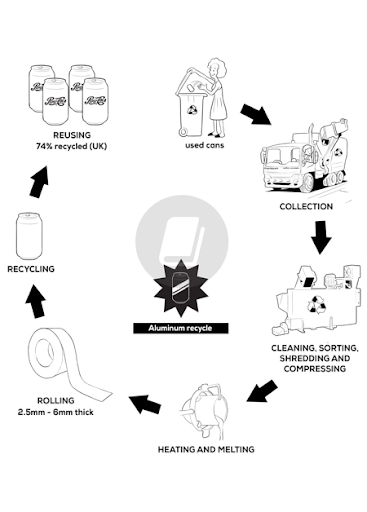The diagram below shows the recycling process of aluminum cans. Summarize the information by selecting and reporting the main features, and make comparisons where relevant. Write at least 150 words.

Bài mẫu
The diagram illustrates the aluminum can recycling process.
Overall, the process encompasses various steps from collecting cans to transforming them into usable products.
Used cans are collected from recycling bins and transported to recycling facilities by trucks where they are cleaned to remove impurities. Subsequently, the cans are sorted to confirm recyclability and separated from non-recyclable waste. Shredding then takes place, reducing the cans to smaller pieces for easier handling.
At the fourth step in the process, crushed pieces undergo melting at high temperatures to be converted into the molten state. This molten aluminum is meticulously poured into molds, where it is shaped into impressively thin sheets, typically measuring between 2.5mm to 6mm in thickness. These thin sheets serve as the fundamental raw material for the manufacturing of various products, with a notable application being the creation of beverage cans. Notably, in the United Kingdom, three-quarters of these cans can be recycled again, contributing to the sustainable reuse of materials.
Từ vựng tốt trong bài
- Impurity (n): tạp chất
Giải thích: the fact that a substance is dirty or lower in quality because it is mixed with another substance, or something that causes this
Ví dụ: Impurities are removed from the blood by the kidneys.
- Recyclability (n): việc có thể tái chế
Giải thích: the capability of being reusable at the end of its useful life to minimize waste, pollution, and resource use
Ví dụ: Recyclability helps retain the highest value of products at the end of their life, enabling their recycling into high-end applications.
- Shred (v): cắt nhỏ, xé nhỏ
Giải thích: to cut or tear something roughly into thin strips
Ví dụ: Shred the lettuce leaves finely.
- Undergo (v): trải qua
Giải thích: to experience something that is unpleasant or something that involves a change
Ví dụ: She underwent an operation on a tumour in her left lung last year.
- Molten (adj): nấu chảy, nóng chảy (kim loại)
Giải thích: molten metal or rock is in a liquid state because of great heat
Ví dụ: Molten lava erupted from the top of the volcano.
- Aluminum (n): nhôm
Giải thích: a chemical element that is a light, silver-coloured metal, used especially for making cooking equipment and aircraft parts
Ví dụ: The first gene for aluminium tolerance has been identified in wheat.
Bạn đang chuẩn bị cho kì thi IELTS?
Hãy tham khảo Khóa Học IELTS Online qua ZOOM cùng cô Thanh Loan
IELTS Thanh Loan – giáo viên 10 năm kinh nghiệm – trực tiếp đứng lớp, tự tin mang đến khóa học chất lượng nhất, phương pháp giảng dạy cô đọng dễ hiểu, giáo trình tự biên soạn cho lộ trình từ cơ bản đến luyện đề chuyên sâu. Đặc biệt, học viên luôn được quan tâm sát sao nhất, hỗ trợ không giới hạn, thúc đẩy kỷ luật học tập tốt để đạt mục tiêu.

Lược dịch tiếng Việt
Sơ đồ minh họa quá trình tái chế lon nhôm.
Nhìn chung, quy trình này bao gồm nhiều bước khác nhau từ thu thập lon đến biến chúng thành sản phẩm có thể sử dụng được.
Lon đã qua sử dụng được thu gom từ thùng tái chế và vận chuyển đến cơ sở tái chế bằng xe tải, nơi chúng được làm sạch để loại bỏ tạp chất. Sau đó, các lon được phân loại để xác nhận khả năng tái chế và tách ra khỏi rác thải không thể tái chế. Sau đó, quá trình nghiền, giảm kích thước của lon để thuận tiện trong quá trình xử lý.
Ở bước thứ tư của quy trình, các mảnh nghiền trải qua quá trình nấu chảy ở nhiệt độ cao để chuyển sang trạng thái nóng chảy.Nhôm nước chảy này được đổ cẩn thận vào khuôn, tại đây nó được tạo hình thành những tấm mỏng ấn tượng, thường có độ dày từ 2,5 mm đến 6 mm. Những tấm mỏng này đóng vai trò là nguyên liệu thô cơ bản để sản xuất các sản phẩm khác nhau, với ứng dụng đáng chú ý là tạo ra lon nước giải khát. Đáng chú ý, tại Vương quốc Anh, 3/4 số lon này có thể được tái chế trở lại, góp phần tái sử dụng nguyên liệu bền vững.
Nên luyện IELTS Writing ở đâu?
Cuốn sách với hơn 100 bài mẫu IELTS Writing Task 1 & 2 band 7.0+
Giá chỉ bằng 3 cốc trà sữa, nhưng bạn có:
1, Tổng hợp đề thi THẬT của các năm trước nên có tỉ lệ xuất hiện lại rất cao
2, Phân tích câu hỏi và gợi ý bố cục bài viết , cách phát triển ý, cùng bài mẫu chất lượng
3, Giải thích từ vựng tốt sử dụng trong bài và bản tạm dịch tiếng Việt

Xem thêm:












